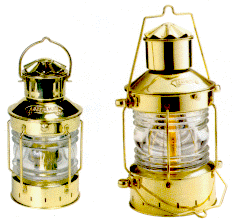
Kerosene Lamps
History of Kerosene Lamps
By Nancy E. Brown - Ezinearticles
After the invention of modern oil lamps and the production of kerosene about 1800, people needed a way to use these lamps to do work outside. The oil lamps used a glass globe and wick to control the amount of air flow around the wick, and protect the flame. But there was much work to be done outside, where these lamps were easily broken. Therefore a much stronger, more protected source of light was needed. So came the introduction of the kerosene lantern, also known as a hurricane lantern. This is a more rugged version of the kerosene lamp, which is designed to be portable. They consist of a metal base, which holds the fuel, and side tubes which securely support the glass globe to prevent breaking.
By Nancy E. Brown - Ezinearticles
After the invention of modern oil lamps and the production of kerosene about 1800, people needed a way to use these lamps to do work outside. The oil lamps used a glass globe and wick to control the amount of air flow around the wick, and protect the flame. But there was much work to be done outside, where these lamps were easily broken. Therefore a much stronger, more protected source of light was needed. So came the introduction of the kerosene lantern, also known as a hurricane lantern. This is a more rugged version of the kerosene lamp, which is designed to be portable. They consist of a metal base, which holds the fuel, and side tubes which securely support the glass globe to prevent breaking.

These lamps had numerous uses in the early 1800's through the 20th century. They were used for lighting homes, and barns, to light horse drawn carriages, on ships, railroad cars, and even early automobiles.

There were different kinds of kerosene lanterns made. One was the dead flame lantern. These were designed to eliminate or minimize the draft which reached the flame. These are also known as non-tubular lanterns. They consisted of a series of baffles inside the top, above the globe, and a series of bottom draft holes, that were positioned so no top draft, or wind could blow directly on the flame. These were often used by the railroads as signaling lights.

Another type of kerosene lamp was the tubular lamp. These contain a ducting system to stabilize and enhance the draft of air reaching the flame, creating a stable, wind resistant flame. They are further divided into the "hot blast" and "cold blasts" styles.

The "hot blast" lanterns are constructed to supply air into the base of the lantern, which is heated by the flame. A portion of the hot air rises into the canopy over the globe, and is pushed by a downdraft through the side tubes to the air chamber beneath the burner supplying the flame. Hot blast lanterns produce a yellow flame.

The "cold blast" lanterns are constructed so the supply of air through the side tubes, does not mix with heated air from the flames. The flame is supplied with fresh air, both through the globe plate and the side tubes. This produces a white flame, and twice the volume of light as a "hot blast" lantern. The most famous manufacturer of tubular lamps, R.E. Dietz, still manufactures lamps today, although his company has moved to Hong Kong and China.

The use of kerosene lamps decreased during the depression. Today most uses for kerosene lamps are supplied with flash lights, and outdoor lights. Kerosene lamps are often collectors items.

Kerosene Lamps

No comments:
Post a Comment
Hi, please feel free to share your comment here.
For example: Which pictures is the best?
Thanks,
Admin